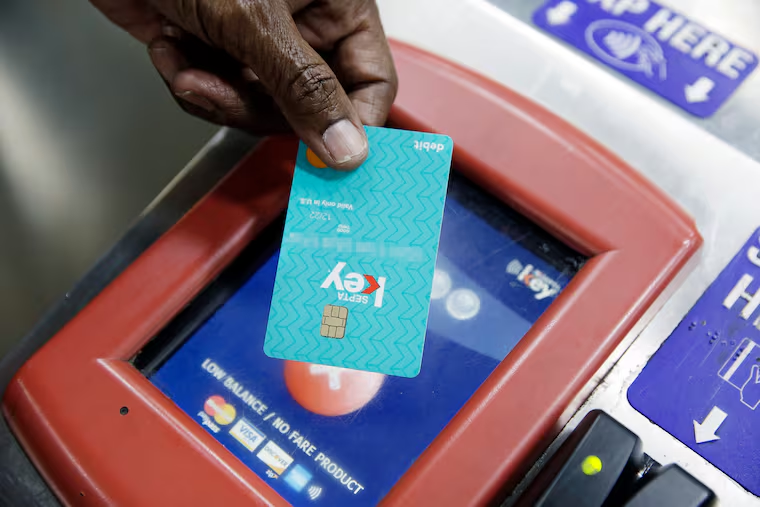After $285 million, SEPTA plans to dump the Key card and seek a system that works with smartphones
The troubled fare system has been costly and the transit authority is looking for something easier to use for bus and train commuters.

SEPTA is looking to ditch its beleaguered Key card fare platform.
After 11 years, the transit agency is shopping for a contractor to build a new fare collection system with more convenient payment options and more adaptable technology.
Key has suffered from delays, glitches and ballooning costs since it was launched in 2016, two years later than expected. SEPTA has paid Conduent Inc. $285 million for upgrades and system maintenance as well as the initial work — more than double the project’s original budget.
“We want to bring this into the future and provide better, easier access to our customers,” SEPTA’s chief financial officer, Nick Grieshaber, said in an interview.
Needed: Open-source technology
For the next iteration of Key, SEPTA requires that most of the software be commercially available and that the system be built with “open architecture,” or technology infrastructure with public specifications rather than proprietary ones, according to the formal solicitation of bids.
“What that really means is that SEPTA will retain control of how everything integrates with the back office,” said Trevor Findley, principal of Clevor Consulting Group, which is among those advising the transit agency on the transition.
For instance, SEPTA wants to be able to run the customer-service operation itself and to adapt the system to a new fare structures, such as free transfers, he said.
Because Conduent used proprietary technology for Key, SEPTA had to go through the company for changes and development of new features, officials said. Most smart-card fare systems at the time worked the same way, Findley said, but transit agencies and computer engineers are moving increasingly to open-source components.
“Let’s say five to 10 years from now SEPTA needs to replace the readers on the buses,” Findley said. “They’re not going to be beholden to the vendor” chosen for this project.
Proposals from companies interested in building the next iteration of the Key program are due July 14. SEPTA says more than 20 firms participated in an orientation session for potential bidders last week. Riders shouldn’t expect to see changes before 2025, and SEPTA estimates it could take about four years for a gradual transition to the new system.
What is Conduent?
In 2011, SEPTA hired Conduent, a Xerox spin-off headquartered in Florham Park, N.J., to design and build the Key Card system for $129.5 million. It was supposed to be operational by 2014. Conduent has come under fire over other projects.
Last December, for instance, Conduent settled for $32 million a class-action lawsuit brought by investors who said the company misled them about its progress in updating its information technology for toll collecting systems.
Conduent is eligible to bid on the new proposal, Grieshaber said. “It’s open to anyone,” he said.
The company did not comment on whether it was interested in bidding on the proposal.
“As a leading global provider of smart mobility solutions, Conduent Transportation is proud to support SEPTA in providing the latest technologies and services to enhance its ticketing and fare collection system,” Conduent said in a statement. “We also look forward to continuing to support SEPTA as it introduces, in the months to come, additional payment options for travelers.”
What riders want
In designing its wish list, SEPTA paid attention to customers’ complaints about the current system and conducted a number of focus groups about what they wanted in a new one, said Henry Rosen, the project manager for the new fare system and a senior technical consultant with engineering firm WSP.
One finding, he said, is that pretty much everybody disliked the in-station kiosks for obtaining, loading and reloading Key Cards. It wasn’t much of a surprise that SEPTA would prioritize an array of methods for riders to pay, from smartphone wallets to credit and debit cards.
“They wanted a simpler process similar to what they see in other major cities,” Rosen said. “We’re basing the design on simplicity. People don’t want to have to wait at machines; they want to be able to basically get on the train or bus and go.”
As of last December, SEPTA has had a smartphone option, called Key Tix, that requires users to download prepurchased tickets to the phone by QR code.
Internally and in the request for proposals document, SEPTA has been calling the project Key 2.0, though officials said there’s been no decision about whether that would be the new system’s consumer-facing brand. “The marketing people may want to come up with something a little more catchy,” Grieshaber said.
This story has been changed to update SEPTA’s spending on the Key Card program.